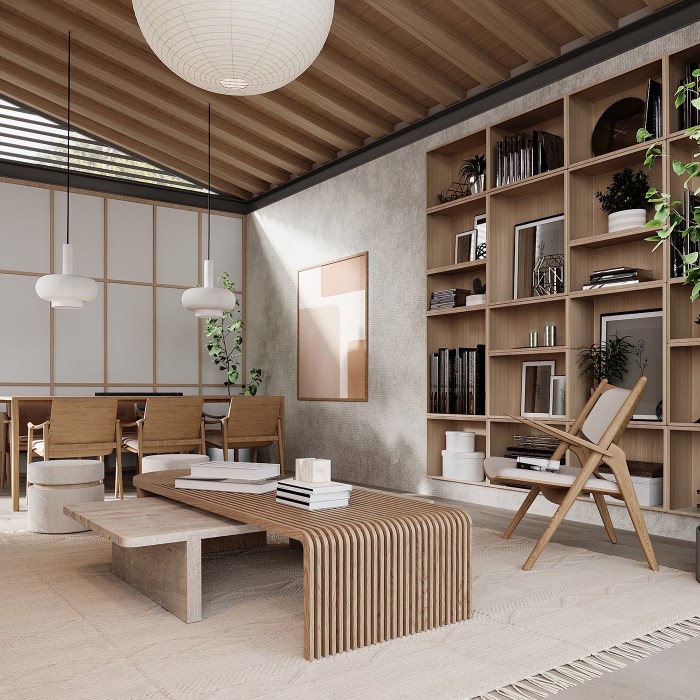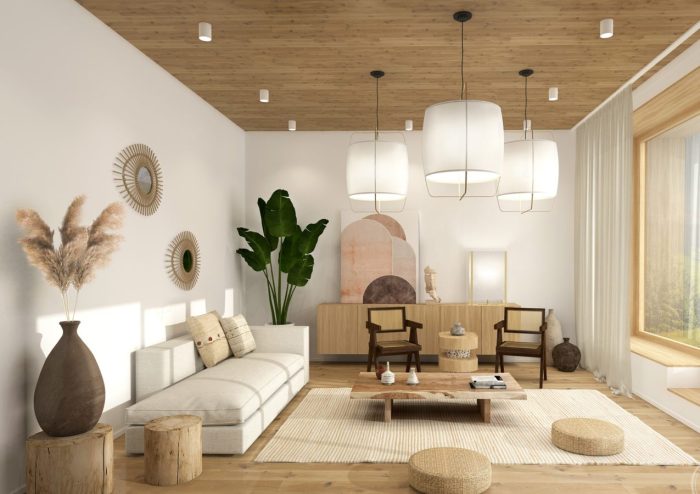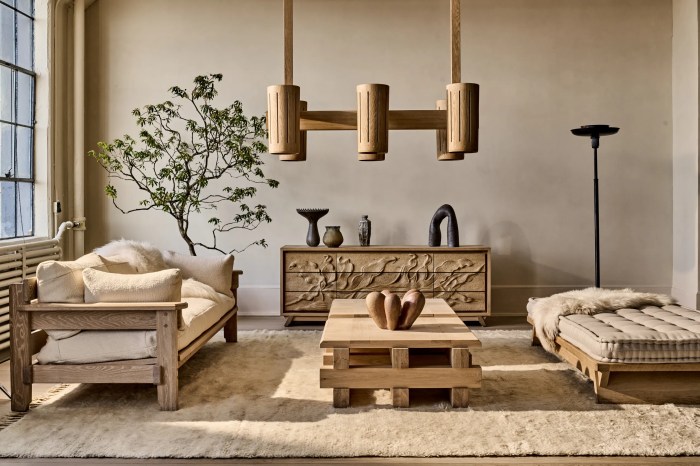Exploring the Fascinating Japandi Style
Japandi sets the stage for this enthralling narrative, offering readers a glimpse into a story that is rich in detail and brimming with originality. The fusion of Japanese and Scandinavian design elements creates a unique aesthetic that has captured the imagination of interior design enthusiasts worldwide.
As we delve deeper into the world of Japandi, we uncover its origins, key characteristics, and how it strikes the perfect balance between minimalism and warmth.
Overview of Japandi Style

Japandi style is a harmonious fusion of Japanese minimalism and Scandinavian functionality, creating a perfect balance between the two design philosophies. This aesthetic combines the clean lines and simplicity of Japanese design with the warmth and coziness of Scandinavian interiors.
Origins of Japandi Style
The Japandi style originated as a response to the growing popularity of minimalism and the desire for a more relaxed and cozy living space. It brings together the best of both Japanese and Scandinavian design elements to create a unique and timeless look that is both calming and practical.
Key Characteristics of Japandi
- Minimalist Aesthetic: Japandi design embraces simplicity and clean lines, with a focus on functionality and practicality.
- Natural Elements: The use of natural materials such as wood, stone, and bamboo is a key characteristic of Japandi style, bringing warmth and texture to the space.
- Neutral Color Palette: Japandi interiors often feature a neutral color palette with soft tones like beige, gray, and white, creating a serene and calming atmosphere.
- Functional Furniture: Furniture in Japandi style is both elegant and functional, with a focus on craftsmanship and quality.
- Clutter-Free Spaces: Keeping spaces uncluttered and organized is essential in Japandi design, promoting a sense of peace and tranquility.
Elements of Japandi Decor
When it comes to Japandi decor, there are key elements that define this unique style. From the color palette to the materials used, each aspect plays a crucial role in creating the perfect blend of Japanese minimalism and Scandinavian coziness.
Color Palette in Japandi Interiors
In Japandi interiors, the color palette is typically muted and neutral, focusing on shades like soft grays, whites, beiges, and blacks. These colors help create a sense of calmness and simplicity, reflecting the minimalist approach of Japanese design and the earthy tones of Scandinavian style.
Natural Materials in Japandi Design
Natural materials are a fundamental aspect of Japandi design, as they bring warmth and texture to the space. Wood, bamboo, rattan, and stone are commonly used in furniture, flooring, and decor pieces. These materials not only add a touch of nature but also embody the simplicity and sustainability that are core principles of both Japanese and Scandinavian design.
Furniture in Japandi Style
Furniture in Japandi style is characterized by clean lines, functional design, and a mix of modern and traditional elements. Common pieces include low-profile sofas, sleek wooden tables, minimalist storage units, and handcrafted ceramics. The focus is on quality craftsmanship and timeless aesthetics, blending the best of both worlds in a harmonious way.
Creating a Japandi-inspired Space

When designing a Japandi-inspired space, it's essential to find the perfect balance between Japanese and Scandinavian elements. This fusion of styles focuses on simplicity, functionality, and comfort, creating a harmonious and serene atmosphere.
Incorporating Japandi Elements into a Room
- Choose a neutral color palette: Opt for earthy tones like beige, gray, and white, which are characteristic of both Japanese and Scandinavian design.
- Minimalist furniture: Select sleek and simple furniture pieces with clean lines and natural materials such as wood and leather.
- Natural elements: Integrate nature-inspired elements like houseplants, bamboo accents, and stone decorations to bring a sense of tranquility to the space.
- Functional decor: Embrace multi-functional items that serve a purpose while adding to the aesthetic of the room, such as storage ottomans or nesting tables.
Balance Between Japanese and Scandinavian Influences
- Japanese influence: Incorporate elements like shoji screens, tatami mats, and bonsai trees to add a touch of traditional Japanese design to the space.
- Scandinavian influence: Include cozy textiles like sheepskin rugs, knit throws, and linen curtains to infuse warmth and hygge into the Japandi decor.
- Mix and match: Experiment with blending Japanese and Scandinavian furniture, decor, and textiles to create a unique and personalized Japandi style.
Achieving a Minimalist Look with Japandi Style
- Declutter: Keep the space free of unnecessary items and embrace the "less is more" philosophy to achieve a minimalist aesthetic.
- Functional design: Choose furniture and decor pieces that serve a purpose and contribute to the overall functionality of the room.
- Organic textures: Incorporate natural textures like wood, stone, and cotton to add warmth and depth to the minimalist space.
Benefits of Japandi Design

Japandi design offers a multitude of benefits that contribute to a harmonious and peaceful living environment.
Calming Effects of Japandi Interiors
Japandi interiors are characterized by their simple and minimalist aesthetics, which create a sense of serenity and calmness in the space. The neutral color palettes, natural materials, and uncluttered layouts help to reduce visual noise and promote relaxation.
Promotes Mindfulness and Tranquility
The fusion of Japanese and Scandinavian design principles in Japandi style encourages mindfulness and intentionality in everyday living. By incorporating elements such as natural light, indoor plants, and functional furniture, Japandi design inspires a sense of tranquility and presence in the home.
Practicality and Functionality of Japandi Decor
Japandi decor focuses on practicality and functionality without compromising on style. The emphasis on clean lines, versatile furniture pieces, and efficient storage solutions makes Japandi design not only visually appealing but also highly functional for modern living spaces.
Closing Summary
In conclusion, Japandi design offers a harmonious blend of two distinct styles, promoting mindfulness, tranquility, and practicality in interior spaces. Embracing Japandi allows for a calming environment that exudes elegance and simplicity.
Detailed FAQs
What sets Japandi style apart from other design trends?
Japandi style combines the best of Japanese and Scandinavian design, focusing on minimalism, functionality, and natural elements.
How can I incorporate Japandi elements into my existing decor?
You can start by introducing natural materials like wood and stone, opting for a neutral color palette, and decluttering your space to achieve a minimalist look.
Does Japandi design work well in small spaces?
Absolutely! Japandi design is perfect for small spaces as it emphasizes simplicity, clean lines, and a clutter-free environment, making rooms appear more spacious.




